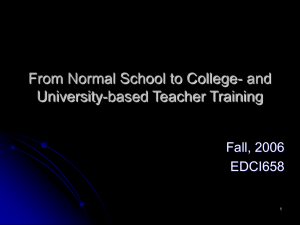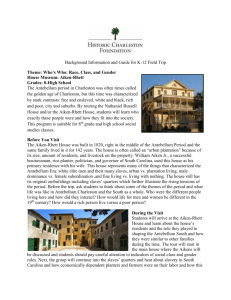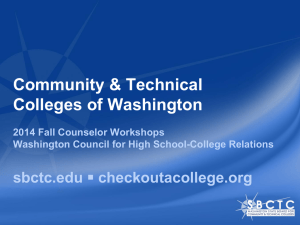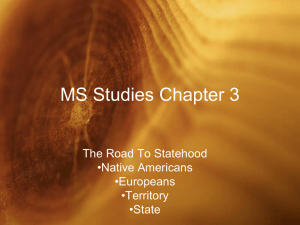Antebellum Colleges
advertisement
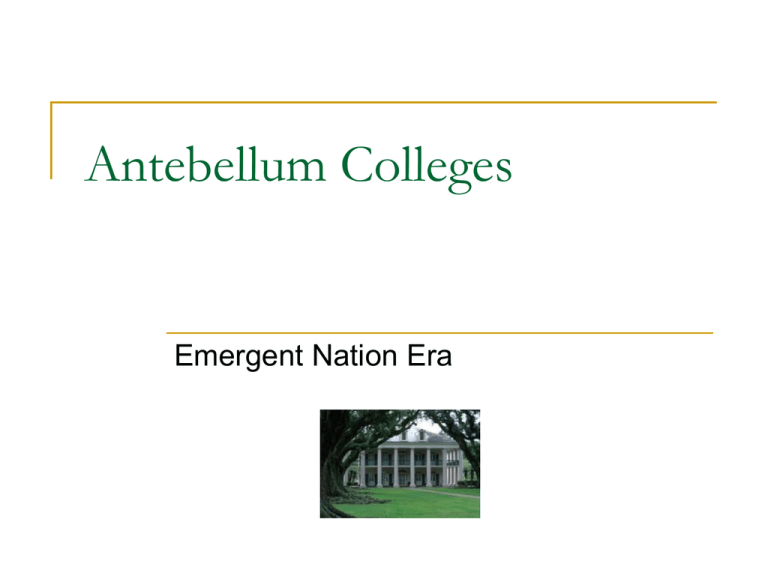
Antebellum Colleges Emergent Nation Era 1790 1869 3.9 M 1,050 141 11 38 M 61,000 5,450 240 Average Enrollment/College 95 240 Number of degrees Conferred 240 9,200 US Population Students in HE HE Faculty Number of Colleges Nation has three regions North: Urban; early industrialization; manufacturing; trade; political influence; wealth South: Agrarian; export cotton/tobacco; anti-intellectual; little social mobility; wealth tied to slaves and land (25% owned slaves, less than 10% owned 20, minimum needed to run plantation) Approx 2.5% of population controls region. West: W of Mississippi River --generally opposed to slavery; ties were to north for trade Antebellum Colleges England: 23 million population, 4 colleges Ohio: 3 million population, 37 colleges Female Seminaries increasing Not “true colleges”-very low admissions standards, little preparatory training Education of Blacks 1st degree 1826, 27 before Civil War Avery College (PA) – first HBCU (Historically Black Colleges & Universities) Miner Academy (DC)-1851 1856 - Wilberforce (OH): oldest private Black University in U.S 1854 – Lincoln (PA): Langston Hughes and Thurgood Marshall alumni During the first one hundred years of its existence, Lincoln graduated 20% percent of Black physicians and more than 10 % of Black attorneys in the US Antebellum Colleges Blacks at University of Virginia 1821-University hires 32 slaves to level campus land, slave owners paid $60 per slave per year 1828 faculty senate “resolved that the President be informed that the faculty disapproves of free Negroes being located w/in the university.” 1832 University purchases a slave, Lewis Commodore, for $580 to be a janitor 1842: Faculty senate approves 13 duties for student owned slaves: bring water, clean rooms, shine shoes, provide firewood, etc. 1955 Blacks permitted to enroll (Wow, this was after my folks were born, not that long ago) 1959: Robert Bland first to graduate –Currently Dept. Manager for Missiles and Launching Systems for the Navy in CA 2007 Bill before VA legislature to apologize for slavery Antebellum Colleges Jacksonian democrats Call for expansion of Higher Ed, excluding women, Blacks, Native Americans, and other minorities. Opposition to Education for all: Raleigh NC newspaper editorial (1829) – “…children should pass their days in the cotton patch, or at the plow, or in the cornfield, instead of being mewed up in a school house, where they learn nothing…I hope you do not conceive of it at necessary that everyone should be able to read, write and cipher…” Beginning of the growth of wealth for some and the American myth of the self made man; education not necessary Wealth resulted in symbol of achievement and distrust of privilege and social inequity Antebellum Colleges Literary Societies Societies-challenged the curriculum in educational importance Capstone Moral PhilosophyAmherst “Character is of more consequence than intellect” Students formed literary societies to change the moral philosophy Invite speakers, produce journals, deal w/controversial topics Yale (1753)-literary club: spread ideas, debates, competitions, discuss relevant topics Princeton – “Ought freedom of thought be granted to all men?” Fraternities/Secret Organizations Intent-bring together small groups to fill gaps from removal of family and home community Beginnings in 1820s Union-Kappa Alpha (1825) 1840- Spread throughout New England and then into Ohio and Michigan High level of loyalty created Led to the decline of literary societies Built better library collections, expanded sciences, improve course offerings Escape dreary days of collegesmoking, drinking, etc. Antebellum Colleges Athletics 1787 – Princeton forbade students to play hockey on the grounds that it is “…unbecoming of gentleman and scholars, and is attended with great danger to the health.” 1820 – Rensselaer official position regarding athletics “such exercise as running, jumping, climbing, scuffling, and the like are calculated to detract from the dignity of deportment which becomes a man of science.” 1826-Outdoor gymnasium movement from Europe arrived at Harvard 1852 – 1st intercollegiate competition held b/w Harvard and Yale: boating 1859 – Amherst and Williams played the first intercollegiate baseball game Beginning of student cultures Campus life was tough/violent Collegians: Sports/frats/”Hail fellow, well met”; cheating common; studied only to stay in school Outsiders: Ministers to be; supported faculty while collegians fought faculty Rebels: Interests in politics; literary society members Antebellum Colleges Student Life/Discipline Elaborate codification of rules and regulations/ Why? 1865 Harvard – 8 pages of fine print; prohibited from leaving campus w/o permission on Sunday, rooms subject to faculty inspection at any time-even off campus!!! WTH (What the he*l) In loco parentis Yale – loyalty oath, active disbelief in the bible was a campus crime\ Union 1802- 11 chapters in rule book; prohibited behaviors included: swearing, drunkenness, striking instructors, card playing Princeton 1885: “That should any students continue to have their washing done in town as heretofore, it must be done under the supervision of the college office.” Faculty carried the responsibility of overseeing discipline- a job/chore that was often not enforced due to their hesitation with enforcement. Antebellum Colleges Faculty Students an important element in the power structure of the institution Early faculty were clergy Faculty taught a single subject, tutors taught entry level subjects in which the college did not have professors Harvard was in existence for 85 years before first full time faculty member; Yale50 years; Princeton-20 years Union College (1795-1884): 130 faculty members, 55 clergy Princeton (1868): 7 of 10 clergy Changing times and changing status of faculty/teacher/clergy Salary: 1805-Dartmouth $600, 1865-Denison $600 Antebellum Colleges Presidents Only mature learned man available to represent college Seldom leave Campus Tradition of strong presidents-change from England Included house, may have shared it w/students Serve as a local minister, perhaps a farmer Role as educator-taught moral philosophy as senior capstone Compensation-contracted but usually not paid Columbia-$1,000 in 1787, $3000 in 1857 Rutgers $1,700 in 1810 (amount voted to pay but actually paid $771.86 over 2 years) Harvard $2,235 in 1840 Antebellum Colleges Presidents Cont. University of TN 1835 job description for president 1. “…general superintendence of the interests and reputation of the University, which he is bound to promote and maintain by every exertion of his power. 2. He is, ex officio, President of the Board of Trustees and of the faculty when present w/them and also the administrator of their decisions in cases of discipline 3. He has a right to be present at the recitation of any class in the institution 4. He will take such branches of instruction into his own hands as he may judge necessary and expedient 5. All religious exercises and studies of the university are committed to his direction, and 6. He is to preside at examinations and commencements and confer all degrees.” Eleazar Wheelock @ Dartmouth – assisted in building college buildings, including his home, cleared 70 acres of land, planted corn and wheat, governed college, taught courses, preached on Sundays and prayed for a new job!! 1868 Martin, president University of Rochester: No class passes through my hands which does not contain more or less young men who are on the eve of ruin from wayward natures, bad habits, or hereditary tendencies of evil. These men must be watched, borne with, and if possible, saved to the world and their families…This work must be done by the president. Those private and confidential reproofs, suggestions, and admonitions which do so much to form manners and character, must be attended to by the president” Stevens at Amherst: We have no faith in the capabilities of mere intellectual training….character is of more consequence than intellect. Antebellum Colleges Governing Boards Trustees drawn from the privileged class Boards delegated much authority to the President and educational matters were left to the faculty but b/c the board retained control over budget, priorities, and planning Wayland @ Brown: “How can colleges prosper directed by men, very good men to be sure, but who know about every other thing except about education. The man who first devised the present mode of governing colleges in this country has done us more injury than Benedict Arnold.” Clergy beginning to leave; Harvard bylaw requiring clergy on Board repealed 1851 Antebellum Colleges Financing the Colleges Harvard and Yale: Early support from benefactors 1795- Rhode Island College becomes Brown for $5,000.00 America had more corn than cash – so colleges often got produce instead of money State Aid 1814-1823: Harvard receives $10,000 per year 1893-1921 NH give Dartmouth $200,000 Wayland at Brown: We cannot induce mean to pursue college unless we offer it below cost or give it away. Perpetual scholarships: sell a tuition scholarship a reduced rate in advance Save money on faculty salaries: Martyrdom on the alter of Christian learning….$600.00 U of GA, 1815; Hanover $335.00 1855

